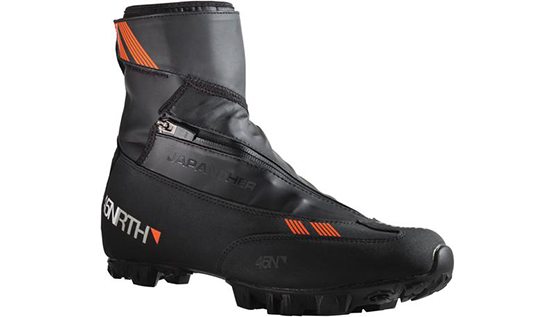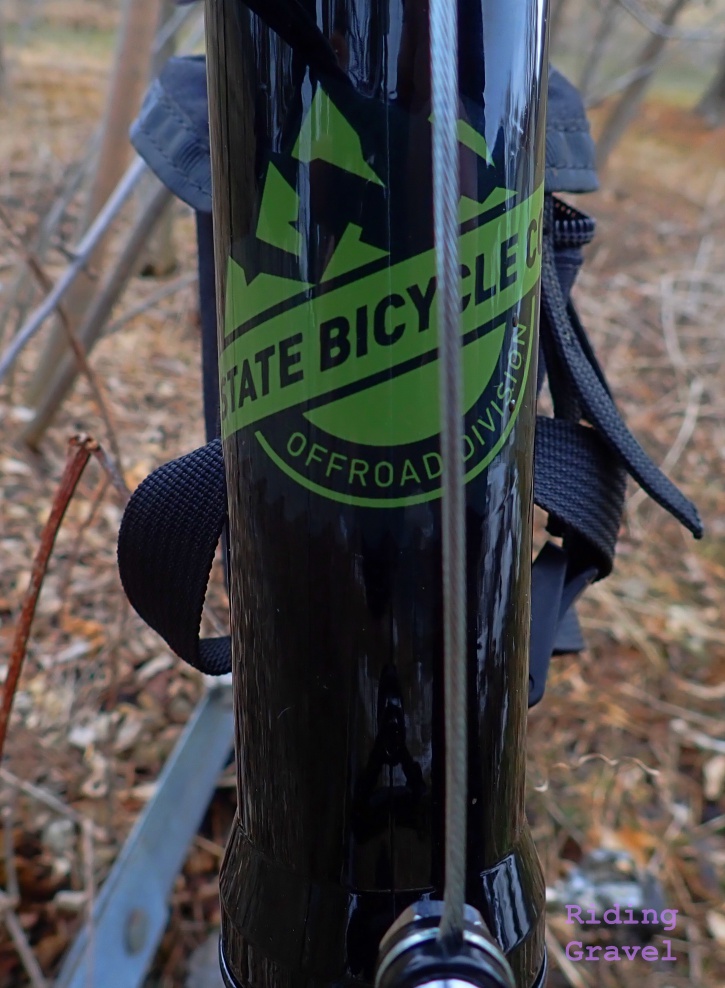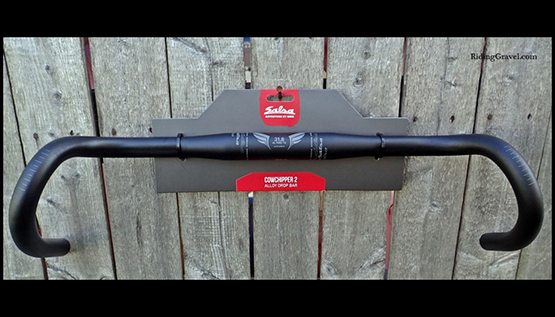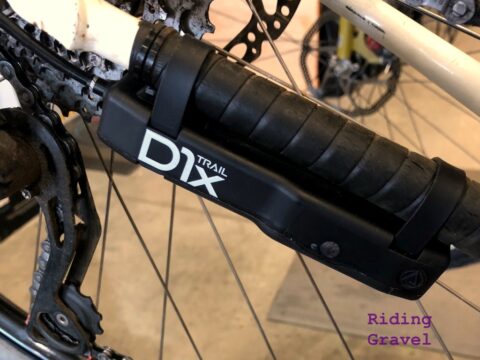Jamis Renegade Elite: At The Finish- by Guitar Ted
The Jamis Renegade Elite has been put through its paces here for a few months now and the final verdict is up. The carbon fiber chassis of this bike is the heart of the experience one has when riding this rig. That said, there are parts and pieces on the bike that bear mentioning and in this post I’ll get around to those before rendering my final say on this stealthy looking rig. Check out the previous “Checkpoint” and “Getting Rolling” posts by clicking on those hyper-linked titles. There is a lot more there for you to learn about this bike.

The Renegade Elite has a lot going for it as a frame/fork, but the components bolted to it are a big part of the recipe here as well. First and foremost is how well the Shimano running gear works on this bike. The Ultegra componentry shifted flawlessly throughout the testing, never needing adjustments. Front shifts were snappy and I never had any hesitations or chain issues with the bike. One finger, easy pressure braking was always on tap with the hydraulic levers. In fact, one could argue that the brakes are too good for gravel. The ergonomics of those levers though! Oh my! That hood position is one of the best for my paws I’ve tried, and I’ve had many Shimano levers that were merely “okay”. But that is always going to be a personal fit issue and you may not agree here. Finally, gearing wasn’t quite my cup-o-tea. The 50/34 crank is not what I would end up with here. I still like my CX style 46/36, but I get it. Some of you have longer climbs and need that deeper gear the 34T granny can give you.

The seat post from Ritchey, the carbon model here, is really nice and contributes a lot to the smooth feel the Renegade Elite imparts on rough gravel. I’m not quite so enamored of the handle bars, another Ritchey product, as they are traditional, non-flared drops. I’d likely swap out to the much more favorable Ritchey Venturemax bars we tested here. But that said, the bars weren’t bad.
The Renegade Elite comes with a fizik saddle which I am intimately familiar with, having used one for a time, and it does a fine job. It just isn’t quite a fit for me, so after the initial test rides I installed a Brooks Cambium saddle for the remainder of the test period. Besides the aforementioned use of the Industry Nine wheels we tested here on this bike, no other changes were made to the Renegade Elite. I did go back to the American Classics for the last few rides on the bike to get a feel for the differences between the wheel sets.
At The Finish: In short- I loved this bike. Despite its few quirks in spec it was a joy to ride. Smoother than you might think on gravel, the Renegade Elite is also stable and with the light weight chassis, it allows you to feel faster and that is always fun. Hills felt less hard, and headwinds less draining. I loved how the bike handles choppy pavement and rough gravel. Grinding out miles was no problem for me on the Renegade Elite.
 Part of that was due to how Jamis used water bottle attachments on the fork. Self-supported, longer rides are attainable when you can have four or five bottles on the bike. The fork mounted cages were never an issue either, despite their precarious positions on the outer legs of the forks. I imagine that if you were to stack it up hard on this bike those mounts might give way, but fortunately I never had the occasion to find out that part!
Part of that was due to how Jamis used water bottle attachments on the fork. Self-supported, longer rides are attainable when you can have four or five bottles on the bike. The fork mounted cages were never an issue either, despite their precarious positions on the outer legs of the forks. I imagine that if you were to stack it up hard on this bike those mounts might give way, but fortunately I never had the occasion to find out that part!
That said, not everything comes up roses on this bike. I was really annoyed every time I had to adjust the seat height because of the awkwardly placed seat post binder. Which, admittedly, isn’t often. However; the lack of tire clearance, for me, was disappointing. With everything this bike has going for it, being limited to 38mm tires, if you want true mud clearances, was a head scratcher. Why not allow room for bigger tires and make this a bike that can go long on the roughest of gravel, or at least allow for much better mud clearances? Then too, that might open up the possibility of using 650B wheels. Perhaps future Renegade Elites will allow for this. I should mention that the steel framed series of this bike model does have room for bigger tires and allows for 650B wheels as well.
Besides that one potential deal killer, this bike is excellent. I can see a person with “more paved than not” ambitions gravitating towards the Renegade Elite. It gives no quarter to popular endurance road rigs and can go places such road bikes cannot go easily, or at all. The gravel conditions in many places do not call out for big, meaty tires, so maybe tire clearances are not an issue where you live. This bike could be all you need then. My experience on the Renegade Elite was mostly positive and fun. As long as I strayed from the truly heinous rock for miles, didn’t expect much for traction in single track, and didn’t get anywhere close to mud, I was having a great time. And isn’t that why we ride bikes in the first place?
Note: Jamis Bicycles sent over the Renegade Elite at no charge for test/review to Riding Gravel. We are not being bribed, nor paid for this review and we strive to give our honest thoughts and opinions throughout










Can you really call it a Gravelbike if won’t accept at least 2in(50mm) wide tires? Appears to be an old school Crossbike.
@Plusbike Nerd- Well, your screen name notwithstanding, can you call a bike anything but a 29″er if it has 700c X 2″ wide tires? (That’s what defined 29″ers in 1999, by the way.)
See, it can get dicey if all you do is pick apart at one detail. First of all, and I’ve said this for years, any bike is a “gravel bike”, but what is a better tool for the job? A 29″er? A “plus bike”, or something else?
As I stated in the review, this is a great gravel bike for some people, maybe not for others. You seem to indicate by several means that maybe you fall into the latter camp. And that is perfectly okay.
I will admit that I go to the Plus side. There is just something special about the way high-volume low-pressure Plus tires perform on gravel. My dream Gravelbike would have 26×2.8in tubeless light-weight Gravel specific tires mounted to i30mm rims and would weigh about 20 pounds for a high-end carbon fiber model or 23 pounds for an affordable aluminum model. A 26×2.8 wheel is about the same height as a 700×25 wheel and therefore wouldn’t require much geometry modification to fit the typical Gravelbike. A 26×2.8 tire and i30 rim is about the lightest way to build a Plus wheel and wouldn’t weigh much more than a 700×45 tire and i23 rim. Plus tires float on top of gravel instead of cutting through it and are therefore fast on gravel. Low-pressure Plus tires provide about 1.5 inches of “tire suspension” and are an inexpensive, low-tech way to make Gravelbikes more comfortable. A Plus Gravelbike makes much more sense than a full-suspension Gravelbike. In my opinion, if you can keep it light-weight, wider is better when it comes to gravel. I hope to see Plus Gravelbikes in the future.
The best thing about the Gravelbike is that it has freed us from the paradigm that Crossbikes (and Roadbikes also) must have narrow tires. Let’s stay focused on how to build the best bike to ride gravel roads regardless of tire width, tire height, or frame geometry. Let’s get past the idea that Gravelbikes must look like or be like skinny tire Roadbikes. I want light, fast, capable, and comfortable on gravel, not a roadbike with slightly wider tires.
As always, ride what you have and ride what you like. But, keep an open mind that Gravelbikes will evolve. When I bought my first full-rigid mountain bike with 26×2.0 tires and a 3x drivetrain 30 years ago, I didn’t imagine that now I would be riding a full-suspension Plusbike with 5+ inches of travel, 29×3.0 tires, and a 1×12 drivetrain. My 20 year old Crossbike will be nothing like my next Gravelbike!
Great review Ted unfortunately I couldn’t agree more. I’ve been watching this bike for 2 years (and have the ability to purchase it at cost) but I won’t pull the trigger until they widen those rear stays. 38c max is a non-starter, heck even 40c max gives me pause these days, 42c max is the sweet spot for gravel bikes I don’t always run a fat tire but need the option to do so. Thanks for confirming my bias LOL
Hi – great article. I am interested in this bike but also the new Norco Search XR (Carbon Ultegra) – have you any thoughts on how these two bikes compare ? Mainly for Winter road biking; a little cyclocross; more gravel riding; some bikepacking. Thanks
just got my norco search xr, it took over 6 months to get, first they sent a search but not an xr then they couldnt find any and when they found one it was with apex and the shop swapped ultegra onto it but shimano was out of derailleurs. there are none left, maybe they’ll produce more for 2019 than 2018.
the norco will take bigger tires than the jamis
just for a couple of rides in on it so far, so far so good, like to lifft the front wheel more thatn i would like on really steep climbs would be my only dislike.
Ted, You mentioned that the steel version (Escapade) has better tire clearance. What are the maximum tires one can run on that 2019 version?
@greg skaggs- I was told that the steel model will accept a 650B X 47mm tire and a 700c X 45mm tire.
I know this is an old thread, but it warrants some added info.
The largest tire the (at least the steel ones) renegade will fit is a 40mm. And I mean a 40 slick, or with very minimal tread. With a 700×40 Maxcis Re-fuse, there was only about 4mm of clearance. A 700×41 Surly Knard bottoms out on the chainstay brace. Plenty of room everywhere else. The chainstay brace is the limiting factor.
Along with not being able to use the advertised tire clearance, I really, really hate the fact that they have the cables running on literally ever tube. Down tube, top tube, seat tube, chainstay, and seat stay. Why?
I like the idea of this bike, and I do like how it rides. But actually using it? The tires I want to use wont fit, even though it says they should. The racks I have don’t fit. The fenders don’t fit…
Its a specialized machine. Its good for gravel racing, and bike packing. It could potentially do a lot more, if it weren’t designed/laid out so poorly.
So this is still an older post. I had my eye on this bike. i already have the Roker Comp and just converted it over to the Shimano 2x 48/31 and 11-40t in the rear. I have thoughts of buying another bike as a retirement in the next year or two. I have thoughts of buying a more gravel/mt bike for when I go to races that have single track or more gnarly gravel than most. My Roker weighs in the 20-21 lb range. I would like to get a mt/cross bike but would like that in the 20 lb. or less range. Not sure that is possible. The only bike I keep hearing mentioned is the Marin.